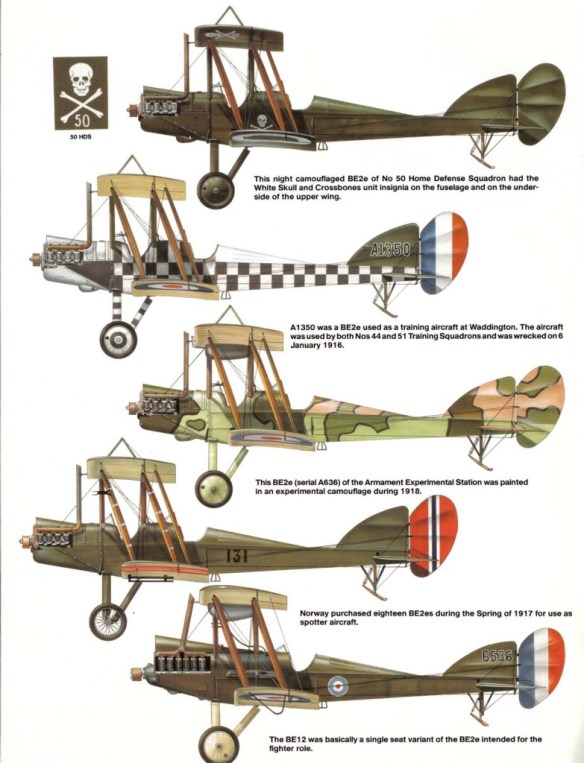Ongoing research at Farnborough revealed that wings with outwardly raked tips were, at the speeds at which aeroplanes then operated, considerably more efficient than any other wing tip shape. Similarly, it was known if wings were superimposed as in a biplane, each affected the efficiency of the other reducing lift and increasing induced drag. Yet the ideal arrangement, the monoplane, if employing the shallow aerofoil sections of the day, required so much additional bracing to maintain rigidity that any aerodynamic advantage was lost. The best compromise was to reduce the span of the lower wing, eliminating struts and wires, and to increase the span of the upper wings, bracing the overhang from kingposts.
A new variant, the B.E.2e, was designed with a new, smaller horizontal tail and with wings following the new arrangement, the span of the upper wing increased by four feet and that of the lower wing reduced by six feet. The wings were rigged at a constant angle of incidence without any washout as the new raked tips were thought sufficient to prevent wing tip stalling. The ply covering to the top and bottom of the fuselage was eliminated and wire bracing substituted. Some fuselage members were changed from ash to steel tube, principally to alleviate problems experienced in obtaining sufficient supplies of good quality ash.
In February 1916, B.E.2c, 4111, was test flown fitted with the new wings and the improvement in both speed and climb was quite dramatic. Lateral control was considered to be ‘very much better’ and landing ‘more easy’. The prototype was first tested fitted with an experimental up-rated RAF1b engine, achieving a top speed of 97 mph, boosting expectations of its improved performance. Since it was decided that this engine was not to be put into production, 4111 was fitted with a standard production 90-hp RAF1a (No. 22971/WD1009). Thus powered, the B.E.2e was 10 mph faster than the B.E.2c and this, together with the improvements in handling, was more than sufficient to ensure that it was put into production as soon as possible. Not only were a total of 1,000 examples placed on order with various contractors, but instructions were given to those building the B.E.2c and B.E.2d to fit the improved wings and tailplane. However, when the completed machines were received, complications arose for it was realised that manufacturers were producing three different machines. All had the same wings and tail surfaces, and looked very similar, but each had a different fuselage. To simplify the matter, especially when it came to the ordering of spares, it was therefore decided that the designation B.E.2e would apply only to those machines built entirely to the new design. Those that had originally been ordered as B.E.2c with the original fuselage would be designated B.E.2f and those with the B.E.2d fuselage would be known as the B.E.2g. Around 200 of each variant were eventually produced. The new wings were viewed with some suspicion, pilots wrongly thinking them structural unsound and a rumour circulated that the extensions would be damaged by violent manoeuvres. Experience proved this to be untrue and confidence in the new type returned.
B.E.2c in a Ground Attack Role
A B.E.2c fitted with armour plate to the forward fuselage as protection against small arms fire from the ground.
The employment of the B.E.2c in a ground attack role, especially during the Battle of the Somme, inevitably led to aircraft being lost to small arms fire from the ground. Perhaps to avoid further accusations that crews were being sent to war in inadequate aeroplanes, a scheme was devised where the forward fuselage was fitted with sheet steel armour plate from the nose to the rear of the pilot’s cockpit. The slab-sided armour, which did nothing to improve the machine’s streamlining, weighed around 440 lbs and seriously handicapped the machine’s performance. Nonetheless, at least fifteen machines were fitted with the armour and saw service on the Western Front. 2028, which had originally been built by Sir Armstrong, Whitworth & Co. Ltd., was with 6 Squadron by 9 September 1916 as an armoured machine. 2122 went to 8 Squadron and at least one example served with 15 Squadron, remaining in service until the spring of 1917 carrying out ground attack and special reconnaissance missions. Other examples known to have been fitted with armour include 2713-2716 and 4093.
